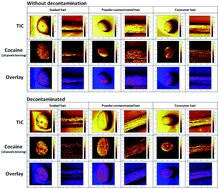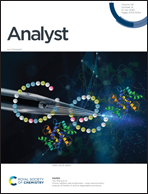Using time-of-flight secondary ion mass spectrometry (ToF-SIMS) and matrix assisted laser desorption/ionization mass spectrometry (MALDI-MS) for investigations on single hair samples to solve the contamination versus incorporation issue of hair analysis in the case of cocaine and methadone†
Abstract
Drug testing in hair is a controversial subject of discussion. Claims that decontamination protocols could generate false-positive samples, by washing contamination in hair, have unsettled many toxicologists. At least for zolpidem (known for showing only minor contamination), it could be shown that differentiation of the drug incorporated via the bloodstream from contamination was possible. The current work addresses cocaine and methadone, known for their high concentrations and contamination issues. Longitudinally and cross-sectioned samples of drug-soaked hair, consumer hair and cocaine powder contaminated hair were investigated using time of flight-secondary ion mass spectrometry (ToF-SIMS) and matrix-assisted laser desorption/ionization-mass spectrometry (MALDI-MS). In addition, the resulting wash solutions were investigated using LC-MS/MS. Differentiation of contamination from incorporation was possible for soaked and consumer hair samples. Therefore, contamination could be localized in the superficial compartments of hair and could be removed using strong wash protocols. In the case of powder contaminated hair samples, a small amount of cocaine remained in the inner structures even after the application of the strongest wash protocols. However, taking into consideration the differences in their behavior during decontamination steps compared to both soaked and authentic hair samples, the validity of this contamination protocol (rubbing cocaine powder into hair) must be questioned. Furthermore, when using cut-off values and metabolite ratios (from routine hair analysis), the differentiation of incorporation from contamination was possible also for all our experimental samples in this study. Inclusion of metabolites and application of cut-off values are therefore a must in routine hair analysis.



 Please wait while we load your content...
Please wait while we load your content...